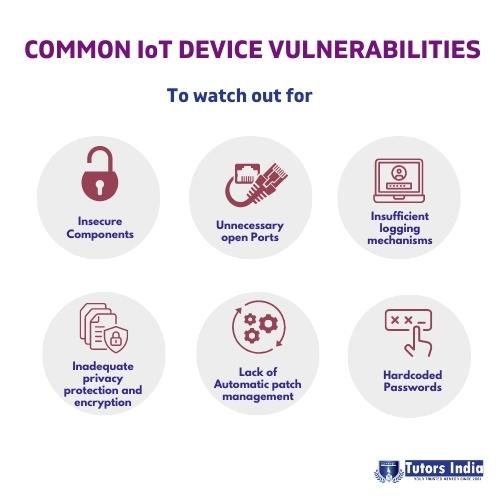The Most Significant Security Threats With IOT Devices
Internet of Things (IOT)
IOT device security has long been a source of concern, which inevitably led to the acceptance of both minor and major threats. The majority of these attacks are the result of straightforward security issues, including the use of telnet services’ default passwords being retained. Below are the 6 major security problem in IOT devices.
Incorrect access control
Only the owner and the people they trust in their local vicinity should have access to the services provided by an IoT device. The security mechanism of a device frequently fails to adequately enforce this, though. IoT devices may have a high level of network trust to the point where no additional authentication or authorisation is needed. Every other computer or device linked to the same network is likewise trusted. When the gadget is online, this becomes a bigger issue since anybody in the globe might potentially use the capability it provides (Yu et al., 2022).
The identical default password that comes with all devices of the same model is a regular issue. For devices of the same model, the firmware and default settings are often the same. The credentials for the device may be used to access all devices in that series because they are known to the public, supposing that they are not changed by the user, which happens often.
IoT devices frequently have a separate account or privilege level that is both externally and internally accessible. This indicates that there is no additional access control after obtaining this permission. Multiple vulnerabilities are not covered by this one degree of security.
Outdated software
It is essential to publish the current version of software when vulnerabilities are found and fixed in order to provide protection. As a result, IoT devices must be deployed with current software that is free of known vulnerabilities and have the ability to be updated to fix any issues that are discovered later.
Lack of encryption
Even if data is encrypted, flaws could still exist if the encryption is incomplete or set up improperly. For instance, a device might not be able to confirm the legitimacy of the other party. Even when the connection is encrypted, a Man-in-the-Middle attacker can still intercept it.
Encryption must also safeguard sensitive data that is kept on a device (at rest). Lack of encryption and storing passwords or API tokens in plain text on a device are typical security flaws. Other issues include the application of weak cryptographic methods or the unauthorised use of cryptographic algorithms (Lv et al., 2021).
Application vulnerabilities
An important first step in safeguarding IoT devices is admitting that software includes vulnerabilities. Device functionality that was not intended by the creators may be activated via software flaws. In some circumstances, this might lead to the hacker executing their own code on the system, making it feasible to harvest sensitive data or target other parties.
It is difficult to totally prevent security vulnerabilities while building software. This is true of all software flaws. There are ways to prevent well-known vulnerabilities or lessen their likelihood, though. This involves using recommended procedures to prevent application flaws, including consistently validating input (Karale, 2021).
Insufficient privacy protection
Sensitive data is routinely stored on consumer electronics. The password for a wireless network is stored on devices connected to that network. Cameras can record audio and video of the house where they are installed. A serious privacy violation would occur if attackers were able to acquire this information.
IoT devices and associated services must handle sensitive data appropriately, securely, and only with the end user’s permission. This is true for both the distribution and storage of private data. The vendor is crucial in terms of privacy protection. In addition to an external attacker, the seller or a connected party may be in charge of a privacy violation (Haque et al., 2022).
Without explicit consent, the manufacturer or service provider of an IoT device may collect data on user behaviour for uses like market research. There are known instances when IoT gadgets, such smart televisions, may be listening in on family conversations.
2.1.4 User interaction
In order to ensure that installed security measures are engaged and properly applied, user contact is a crucial element. If changing the default password is feasible but the user is unaware of it or unable to use it, it is pointless.

Figure 1: IOT device Vulnerabilities
3.0 Conclusion
Without a doubt, access management and exposed services are the main security & privacy issues. IoT devices should also use best practises security safeguards like encryption. By offering documentation and communicating with customers and security experts, vendors may encourage the secure usage of their goods. Devices should be physically secured to make it more difficult for attackers. Finally, if a device is hacked, it should reject the attacker’s apps and alert the user to a problem.
References
- Haque, A.K.M.B., Bhushan, B. & Dhiman, G. (2022). Conceptualizing smart city applications: Requirements, architecture, security issues, and emerging trends. Expert Systems, 39 (5). DOI: 10.1111/exsy.12753.
- Karale, A. (2021). The Challenges of IoT Addressing Security, Ethics, Privacy, and Laws. Internet of Things, 15. pp. 100420. DOI: 10.1016/j.iot.2021.100420.
- Lv, Z., Qiao, L., Kumar Singh, A. & Wang, Q. (2021). AI-empowered IoT Security for Smart Cities. ACM Transactions on Internet Technology, 21 (4). pp. 1–21. DOI: 10.1145/3406115.
- Yu, Z., Song, L., Jiang, L. & Khold Sharafi, O. (2022). Systematic literature review on the security challenges of blockchain in IoT-based smart cities. Kybernetes, 51 (1). pp. 323–347. DOI: 10.1108/K-07-2020-0449.

 Previous Post
Previous Post Next Post
Next Post